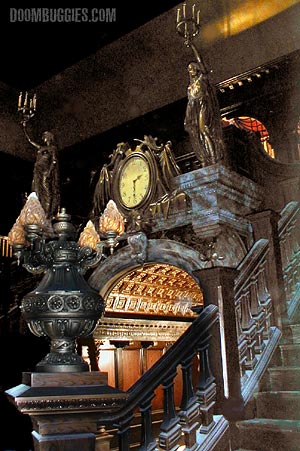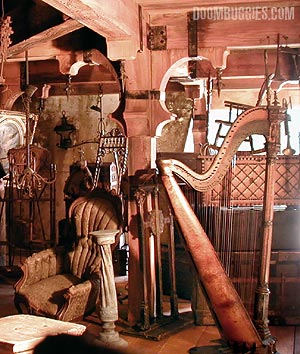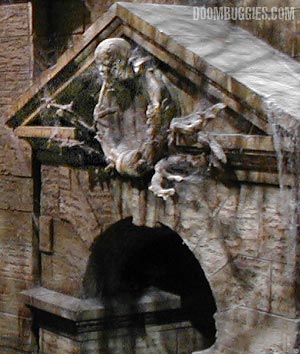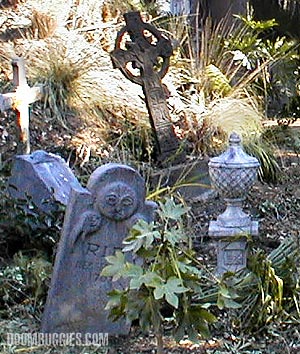
From the Theme Parks to the Silver Screen
Chef Mayhem Explores the Sets Part 2: The Soundstages of The Haunted Mansion
The sets
The most striking thing about walking through the sets of the Haunted Mansion film is the scale. Each room has been super-sized, it seems. The grand entrance hall is a lush, vaulted wonder of polished hardwood and marble statues. Majestic staircases lead up to a library atop the hall on the second floor. Gilded detail abounds. However, at the time I was visiting the sets, this set was being dressed for the present time, so the 19th century splendor was reduced to a dusty, musky palace of decay. At the end of the hall, the room opens out into an armory, lined with rare specimens of all types of armor from around the world.
The plot of the film takes the viewer back and forth through time, so the sets were all designed to be shiny and extravagant, yet convertible to drab and dreary from the passage of the years. This is no small feat, as the Haunted Mansion seems infinitely enormous from inside (much like the ride that inspired it.) As I was walking through the grand ballroom, the set was in the process of being redressed. Rich tapestry and curtains were being distressed and shredded, and cobwebs were being liberally applied to the posts, molding and details of the room. In the center of one of the walls, an enormous (and fully operational) walk-in fireplace stood empty, waiting to be set ablaze for another scene.
|
Pictured: Detail from the grand foyer, looking
from a winding staircase toward a magnificent hall leading into the
belly of the mansion. Note the intricate woodwork and attention to
detail that makes this set a true cousin to the theme park attractions.
|
 |
At the end of the ballroom, two large spiraling staircases wrapped their way up either side of the room, while an enormous pipe organ was nestled in between them… another popular feature of the ride that wasn't forgotten. Large columns and plenty of marble finished the details-although the room maintained an open, spacious feel, which is necessary for the heavily populated scenes that occur in that space.
For a fan of the Haunted Mansion attraction, moving through these sets was an exercise in restraint. Each set clearly reminded the viewer of the corresponding site in the ride-yet the airy, livable space made me want to run and around and hide in the dusty corners, play in the cobwebs, and finally realize what it might be like to actually inhabit the ride I've enjoyed since my childhood. At one point as we were making our way to the attic set, I found myself walking through an immense, seemingly endless corridor of heavy, dark doors with complex carved decorations-a fantastic recreation of a memorable moment in the ride.
Passing the master bedroom set, the guide noted that the bed that they had obtained for the scene was valued at over $50,000. However, it was only being rented, and wasn't a property owned by the production. Finally entering the attic, we could scarcely move through the massive collection of hatboxes, bundles, and baubles of all shapes and sizes. Old Asian paper parasols hang in a row next to piles of blown glass bottles of various shapes and sizes. All manner of old toys, dusty furniture and antique goods cluttered the room to overflowing, although a passageway through the junk was carefully taped to the floor to establish marks for the actors, as the attic was still a hot set in the midst of production.
The attic also provided one of the clearest examples of the work that cinematographer Remi Adefarasin (About a Boy, HBO's Band of Brothers) has put into the production to create an eerily-lit atmosphere of fear and mystery. The high windows of the cupola would give the setting a ghostly, stormy hue, while beaten and broken shutter slats in another corner of the attic will let in slices of light that form sharp beams in the attic dust when lightning flashes.
 |
The cluttered attic set was a wonderful tribute to the scene in the ride, filled to overflowing with boxes and bottles and trinkets galore. As Jason Surrell puts it in his book The Haunted Mansion: From the Magic Kingdom to the Movies, "The two houses [meaning the film Mansion and the Disneyland Mansion] aren't identical twins, but they're at least first cousins." Production designer John Myhre also allowed that he had been a fan of the ride since his childhood as well, so its influence was defintely felt through his designs for the film's settings. |
|
Pictured at right: Detail from the incredible mausoleum set. Decorated with amazingly lifelike wrought-iron accents and weathered stone walls coated in thick cobwebs, the eerie atmosphere was palpable even in a well-lit set. Mechanical effects are built right into the walls, where hundreds of urns and coffins will quake after being disturbed. As the mausoleum is supposed to be located in a New Orleans graveyard, the ground level is completely flooded as many low-lying gravesites are in that geographic area, making an easy escape difficult. |
 |
Finally leaving the attic set, we moved past an overgrown glass-walled conservatory and paused in front of an enormous stone mausoleum façade, which was guarded by two stone statues, shrouded in a perpetual state of mourning. They each held a bronze torch, illuminating the passageway into the crypt. This façade had been used in exterior shots of the Mansion's graveyard, but was now being stored inside of the studio warehouse. Not far beyond it was the entrance to the mausoleum's interior set-a massive showcase, detailed far beyond the effort put into most film sets. The crypt seen in the exteriors of the graveyard is simply the means to enter this massive underground home to generations upon generations of Gracey family descendants. True to its New Orleans setting, the underground mausoleum is completely flooded, and the heights of the underground tomb are decorated with intricate cast iron adornments, while a large iron bridge sets in the corner of the room over the swampy water. Roots from the trees and plants that choke the graveyard have invaded the space and run down the sides of the stone room, mingling with wispy cobwebs. All around the walls, hundreds of urns are set into recessed spots in the stones, while coffins are set on stone platforms that rise out of the murky liquid. The urns and coffins are, of course, rigged for practical special effects-for, as any fan of the ride knows, the ghosts that haunt this particular family legacy are "dying to meet you;" in fact, they can "hardly contain themselves," as the ride narration goes.
Finally leaving the sets behind, I inspected a model of the production's enormous graveyard set (which was filmed separately on location). Age upon age of stone markers and monuments were piled around raised graves and tombs (which is common among graveyards in New Orleans, as the ground water would otherwise disturb coffins buried underground.) Willows drooped mournfully over the gravestones, and a row of suspiciously familiar statue busts was set amid the memorials. I prepared to leave the studio with a new respect for the creative team assembled to put this film together. Sharing a few last words with producer Don Hahn, I discovered that Hahn hoped to move the sets to one of Disney's Hollywood-themed amusement parks to become a walk-through experience for guests in anticipation of the film's release this fall. The sets certainly deserve the closer scrutiny, and the team deserves a lot of credit for their faithfulness to the classic attraction that the film is based on—faithfulness that promises to make this film a treasure for long-time fans of the world-famous ride.
|
Pictured: Detail from the immense graveyard set, which was constructed in an oak grove on location at Sable Ranch in the canyons of southern California. This huge set will play a promient role in the film, and fans of the attraction can again rest assured that the filmmakers were intent on keeping the original ride in mind at all times. Notice the tombstone pictured at right which reads "RIP Nekeesorf, 1707." This prop is a direct homage to the ride, and it is identical to tombstones that you pass in your Doom Buggy in the Disney attraction. |
 |
On the next page: DoomBuggies.com staffer "Wolf" shares another report from the soundstages!



